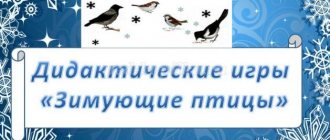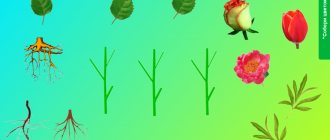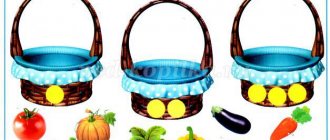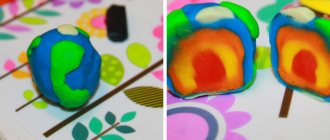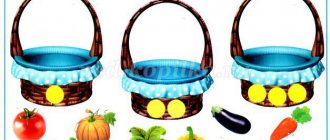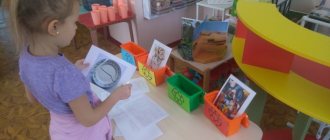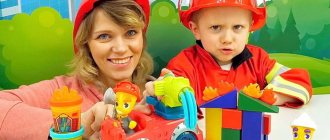Goal: to develop interest in physical education and sports. Objectives: • To form a first idea about the Olympic Games and winter sports. • Develop cognitive activity and curiosity. • Increase your motivation to exercise.
In 2014, our country hosted a bright and large-scale event - the XXII Olympic Winter Games. In a preschool educational institution, we made a project “Together we will win!” Dedicated to these games. To make children's learning about the Olympic Games and winter sports more interesting and exciting, I have created several educational games. Didactic games, compared to other types of games, have one feature - they are a source of knowledge in both sports and physical education. It is not difficult to play such games in this era of ICT. We download the images, make up the games, print them and laminate them to make them last a long time. And now every year, when the “Winter Sports” themed week is held in January, teachers use them in their work. In continuous educational activities, ideas about the Olympic Games and winter sports are formed. At the same time, children develop citizenship and patriotic feelings. After all, such a large-scale event as the XXII Winter Olympic Games took place in our country in Sochi. This topic also makes it possible to generate interest in the events taking place in the country, to cultivate a sense of pride in its achievements, and respect of compatriots for athletes. Children, learning a lot of new and interesting things about the sports life of our country, the Olympic Games, athletes participating in the Olympic Games, come to the conclusion that physical education and sports are very interesting and beneficial for health. They have a desire to be like great athletes and to play sports. Most often, there is a desire to implement knowledge about the Olympic Games and winter sports in independent activities. Lotto “Equip an Athlete”. Goal: to teach children how to select suitable equipment for athletes. Lot “Pictograms of Sochi 2014” Purpose: to teach children to name sports and choose the appropriate pictograms.
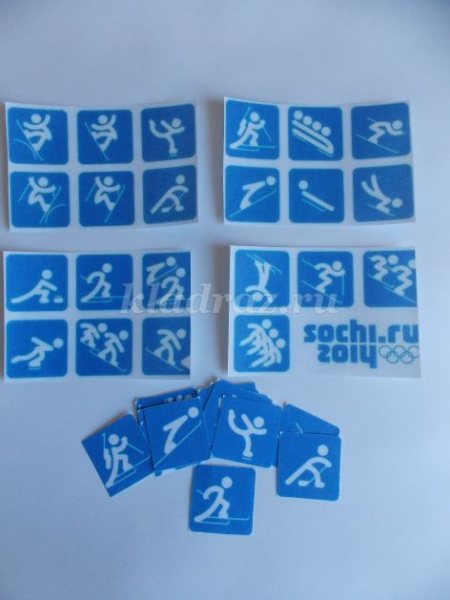
Game "Choose a pictogram". Goal: to consolidate children's knowledge about Olympic winter sports. You must select the icon of the corresponding sport and give it a name.
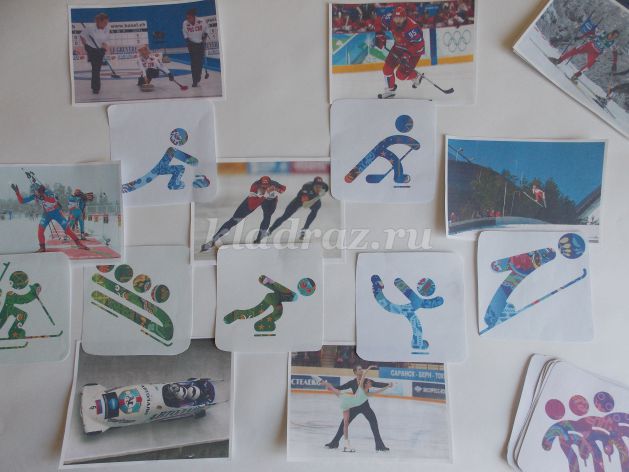
Game “Find the Fragment” Goal: developing the ability to compare objects, establish their similarities and differences. Children are given small pictures made from fragments. It is necessary to find which image they belong to.
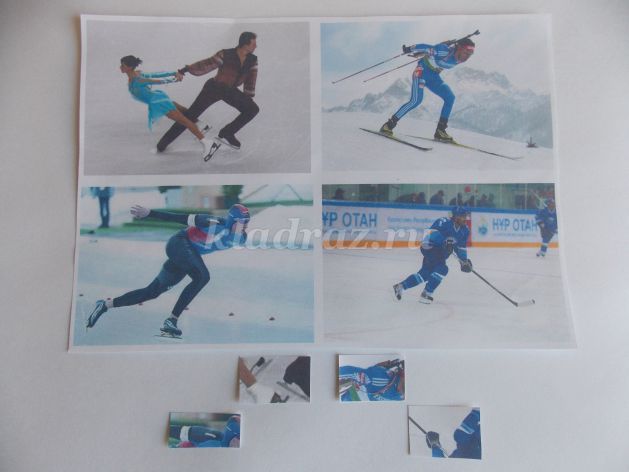
Game “Find a Pair” Goal: to teach children to choose the same pictograms, made in a strict and laconic monochrome palette, and the corresponding pictograms, made in a “patchwork” palette.”
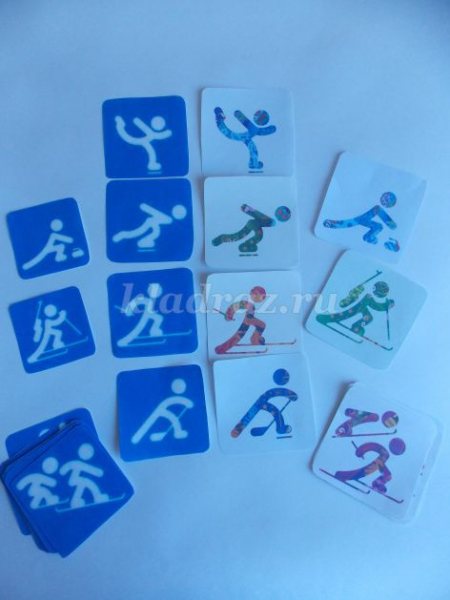
Game “The image crumbled” Goal: development of attention, memory, thinking, perseverance, motor skills. You must first assemble the picture according to the sample, then without it. Pictures – winter sports, symbols of the Olympic Games in Sochi 2014. Game “Fold the track”. Goal: developing the ability to compare and group by color, developing color combinations (fixing the names of primary and secondary colors), the ability to distinguish similarities and differences in color.
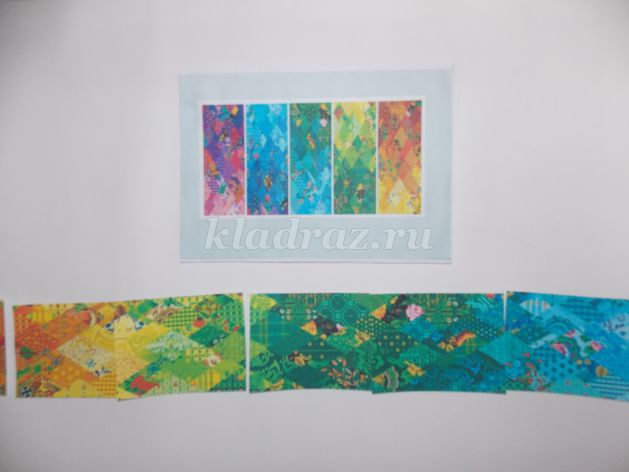
Game “Fourth Extra” Purpose: to teach the names and distinguish between winter and summer sports.
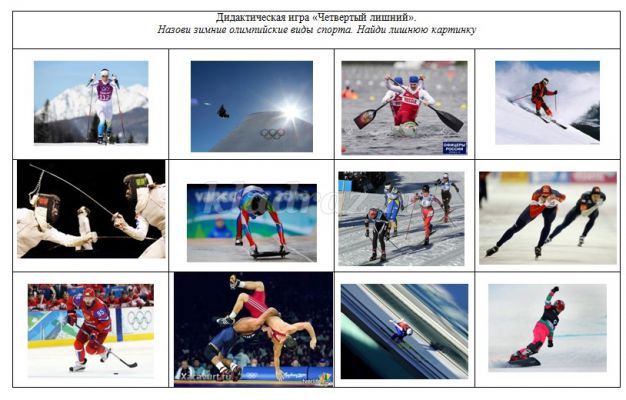
Card quiz Purpose: to strengthen children's knowledge about the Olympic Games and winter sports.
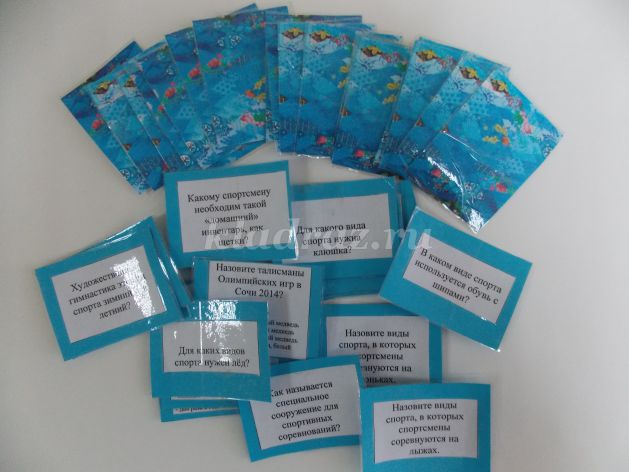
We recommend watching:
Story game for children 5-7 years old Intellectual game for children 6-7 years old. Preparing a child for school Didactic manual on music for children of the preparatory group of a preschool educational institution Didactic games on ecology for children of the preparatory group of a kindergarten
Similar articles:
Ball games for children 6-7 years old
Fun games for children 7-8 years old
Autumn games for children of the preparatory group in kindergarten
“Connect the dots” tasks for children 6-8 years old
Games for the development of logical thinking for children 6-7 years old in kindergarten
What else to read: Didactic game “Berry, Vegetable or Fruit?” 5-6 grade
Dominoes "Different balls"
Age: 5-7 years. Goal To expand knowledge about the types of balls and the variety of games with them. Objectives : to consolidate the understanding of the types of balls and their use in sports and outdoor games; — enrichment of vocabulary on the topic of sports, sports equipment; — improvement of finger motor skills; - development of concentration, ability to think logically; - learning how to interact correctly with peers.
Before the game, preschool children have a conversation about balls, outdoor and sports games where balls are used. This game features balls: soccer, volleyball, basketball, tennis, rubber, inflatable. How to play 2-4 participants can play at the same time. Each player is dealt seven cards (dominoes), free cards are sent to the reserve. The right to make the first move is determined by lot (you can throw a die). Then the move proceeds clockwise and the next player must place a card in accordance with the image of the balls (following the principle of classic dominoes). If a player does not have a card to move, then he takes one card at a time from the reserve until a card suitable for a move appears or the free cards run out. If there are no more cards in the reserve, then the player who has nothing to move misses his move. The game ends when one of the players has laid out all his cards.

Here you can download the didactic game Different balls for color printing in PDF format
Didactic game with clothespins
"Winter and summer sports"
Age 5-7 years Goal To introduce preschool children to the concept of winter and summer sports Objectives - to teach to distinguish and name winter and summer sports; - develop fine motor skills of the hands; - develop thinking, imagination, speech.
Cut and laminate a large circle. Cut out individual cards and glue them to wooden clothespins.
Before the game, a conversation is held with the children about the fact that there are winter and summer sports, using riddles to talk about the sports presented in the game ! the file contains riddles for conversation How to play The child is offered a circle with sectors marked with snowflakes and suns. The child must attach a clothespin with a picture of a winter sport to the sector with a snowflake, and a summer sport to the sector with the sun.
If you make several sets of circles and cards, children can compete. The game can also be used for physical education activities and holidays. The game can be replenished with other cards that correspond to the goals of the game. Looks like that

Here you can download the didactic game Winter and summer sports for color printing in PDF format
Didactic game
"Sport equipment"
Age 6-7 years The set includes 8 cards depicting sports equipment - 48 pictures. For the card you need to print it twice, the second copy is cut into separate pictures. The set also includes 7 cards with a brief description of sports equipment.
Goal To familiarize children with the variety of sports equipment and its purpose. Objectives - To expand knowledge about sports equipment, its purpose, and the types of sports where sports equipment is used. — Develop long-term visual memory and attention. — Cultivate interest in physical education and sports. Before the game , review with the children all the cards depicting sports equipment. Have a conversation about what the sports equipment is called and what it is used for. There are several options for the game: Option 1 Individual game (with a teacher) The child selects a picture and overlays it on the playing field with the same pictures. After the child has found the picture, he must name the sports equipment that is depicted on it. Explain how this equipment can be used. Option 2 Collective game using the playing field and cut cards. 2-8 people + the leader play at the same time. The presenter distributes large cards to the players. The cut cards remain with the presenter. The presenter takes out one card at a time and shows it to the players; the card goes to the player who has it on the playing field, and if the player named the inventory correctly. The winner is the one who is the first to fill his playing card with cards and correctly name the sports equipment where it is used. Option 3 Collective game using only cut cards. From 2 to 8 children play at the same time. All cards are shuffled and laid out in a deck, face down. Players take turns revealing cards in a clockwise order. The player who opened the card must name the sports equipment; if the equipment is named correctly, the player takes the card for himself. If the inventory is not guessed, the card is placed face down next to the deck, and the turn passes to the next player. After playing the first deck, players play the second. The one with the most cards at the end of the game wins. Complication - the card can be picked up if the player tells where the equipment is used. Looks like that:

Didactic game in physical education for preschoolers paired cards
Card index "Didactic games for physical education of preschool children" middle group
middle group
Completed by the teacher:
Karataeva O.N.
"Sportmemorina"
Goals and objectives: to develop children’s interest in physical education and sports; teach children to recognize and name sports; develop memory. Rules: 2 – 6 people play. Paired cards with sports symbols are laid out face down on the table in random order. Players alternately turn over two cards. If the symbols on the cards are the same, then the player takes them for himself and makes the next move. If the symbols are different, then the cards are turned over and the next player makes a move. The game ends when the players have all the cards. The one who collects the most pairs wins.
"Sports in winter and summer"
Goals and objectives: to develop children’s interest in physical education and sports; teach children to recognize and name sports; develop logic, memory, thinking, ability to classify and sort sports. Rules: The player is asked to select symbols (images) of only winter or only summer sports. Then he names these sports; explains why they are summer or winter; tells how the winner is determined.
Game "Find your house."
Goal: consolidating knowledge about the types of formations (circle, line, in pairs, semicircle), improving the ability to quickly navigate in a changed environment.
Rules of the game: line up according to the signal guidelines.
Benefits: planar figures, one for 5-6 children: a circle, a semicircle, a wide and narrow strip-path (these figures can be made from oilcloth).
Methodical instructions: three or four subgroups of children are lined up facing each other; all children walk and run around the room without bumping into each other. At this time, the teacher lays out visual landmarks for construction. At the signal “Home!” children run to their place of formation and line up as the figure suggests: in a line, in a circle, in a semicircle.
When repeating the game, the teacher changes the location of visual landmarks so that all children practice different formations. The subgroup that builds faster and more correctly wins.
Game "Two Pools".
Purpose: exercise in orientation in space.
Rules of the game: You can enter the pool only with tickets and at the “Swim” signal, without bumping into each other.
Benefits: on the floor of the group room, two “pools” are built from building material (or using cords) - a narrow and a wide one with entrances on one side.
Guidelines: next to the pool there is a cash desk. Children take turns “buying” tickets. Some are narrow, others are wide. At the teacher’s signal, children enter the “pool” according to the ticket form (with a narrow ticket - into a narrow pool). Children imitate the movements of swimmers and divers. At the teacher’s signal, they leave the pool and place tickets into boxes (with the corresponding mark for a narrow or wide pool).
"Sport equipment"
Goals and objectives: to develop children’s interest in physical education and sports; introduce children to sports equipment; teach children to recognize and name sports equipment, determine its purpose; develop thinking, attention, memory, logic. Rules: The set includes cards with black and white images of sports equipment and color parts of these pictures (from 3 to 12 parts). The child selects a black and white picture and superimposes the colored parts of the picture onto it. After the child collects the picture, he must name the sports equipment that is depicted on it. Complication: Collect a picture without relying on a black and white image. Explain how this equipment can be used.
"Two halves"
Pictures depicting sports equipment and the main types of equipment movements are cut into two halves.
Goals and objectives: teach children to recognize and name sports equipment, basic types of movement; develop thinking and memory; develop interest in physical education. Rules: 1 option. The child puts the two halves together to make a picture. Option 2. The child looks for the desired half in a stack of pictures. Having collected the picture, the child must name what is depicted on it. Option 3. Having collected the picture, the child must name what is depicted on it. If this is a movement, then the child must show it. If this is equipment, then the child must find it in the group and show what exercises can be performed with it.
"Good and bad"
Goals and objectives: to teach children to a healthy lifestyle; teach children to compare good and bad, useful and harmful; instill in children the desire to lead a healthy lifestyle; develop thinking, logic, memory. Rules: children are given cards that depict situations harmful to health. Players must determine why it is harmful and find a pair of cards that depict a situation that is healthy.
“Relax actively” (cubes)
Goals and objectives: to develop interest in motor activity; teach children to recognize and name types of outdoor activities; develop memory, thinking, logic. Rules: assemble the cubes so that you get a whole image, based on the finished picture. Complication 1: after collecting the image, the child must name what is shown in the picture. Complication 2: assemble an image from memory without relying on a finished image.
"Sports Domino"
Goals and objectives: teach children to recognize and name sports; develop memory, logic, thinking. Rules: The dice feature symbols of sports. 2 – 4 people play. Before the start of the game, the dice are laid face down on the table and mixed. Each player chooses any seven dice. The remaining bones remain on the table - this is the “bazaar”. The player who has the double picture tile goes first. If several players have a tile with a double picture, then the first player is chosen by counting. Next, the players take turns placing dice to the right and left of the first, placing the same picture of the other to the picture of one dice. If the player (whose move) does not have a dice with the required picture, then he takes a dice at the “bazaar”. The one who has no dice left (or the fewest) wins.
Game “Who knows the most moves?”
Goal: to consolidate the names of the types and methods of walking, running, jumping, climbing, throwing.
Rules of the game: accurately name and correctly show movements; You cannot repeat movements called by other players.
Benefits: five cards, each of which depicts a person performing one of the basic movements (walking, running, jumping, climbing, throwing); physical education aids: balls, hoops, gymnastic benches, flat track (at the discretion of the teacher); stationary physical education equipment (if the game is played near it).
Methodical instructions: children are divided into two teams. One of the players from the first team mixes the cards, the second (from the other team) draws one of them. The game begins with the movement shown on the card. If the card shows walking, children remember all its types and methods. The first team agrees on what movement they will perform and then shows it (if possible synchronously), the second team names the type of movement in unison. Then one of the types or methods of this movement is performed by the second team, and the first one names it. The game continues until the children remember all the types and methods of movement shown on the card. A team that fails to show or call the required movement in time receives a penalty point. The team with the fewest penalty points wins. The result can also be calculated by the number of movements performed.
Note: To stimulate gaming excitement in children in this and other games, you can use special chips. For example, for each movement shown, the team receives a red chip, for the correct name - a blue one. At the end of the game, the teams count the number of these and other chips, their total number. Based on the results, the winning team is determined.
Game "Pass the Ball"
Goal: to develop the ability to apply known movements in a specific situation.
Rules of the game: You cannot use the same movement twice. Start passing the ball only at the signal. Perform the movements correctly, having previously named them.
Benefits: ball (any size) for each playing pair.
Methodical instructions: two teams (3-5 people each) take part in the game, which line up opposite each other at a distance of 2-2.5 m. The balls are in the hands of the children of one of the teams. At the signal, children pass the ball to a partner from the other team standing opposite, using any movement (throw the ball, hit the floor, run up and pass it, roll it, etc.). Different ways of throwing - from the chest, from below, from behind the head, etc. - should be considered different movements. A team that repeats a movement that has already been used receives a penalty point. The team with the fewest penalty points wins.
Game "Competition"
Goal: to develop the ability to transform familiar movements in the right direction to solve a given problem.
Rules of the game: perform as many different movements as possible, clearly naming the serial number of each new movement. When all the movements are completed, loudly say the total number of movements performed (for example: “Five!”, “Seven!”). If the movement is performed a second time, then the performer stops the action, names the number of movements performed and gives way to another player.
Aids: a wooden block with a diameter and height of 15-20 cm, an arch, a chair, gymnastic benches.
Methodical instructions: in one game it is recommended to use no more than 3-4 items if there are two or three players, and 1-2 if more than three children are participating in the game. Players, at their discretion, can change the arrangement of objects on the plane (vertically, horizontally, etc.). “One, two, the game begins!” - these words, spoken in chorus, are a signal for the start of the game. One of the players begins to perform a movement on any of the aids placed on the court, having previously named its serial number, for example: “The first is jumping,” and gives way to another player who performs another movement on the same aid. If none of the players can perform a new movement using this manual, then each of the children names the total number of movements performed. The game continues using another aid. The overall result is summed up by the number of movements performed on all aids.
Game "Tourists"
Goal: to develop the ability to adequately use movements to achieve a goal.
Rules of the game: each “tourist” or group goes through the route in their own way, i.e. using movements not used by other players. Act in a coordinated manner in the game, help those who have difficulty performing movements.
Aids: any stationary physical education equipment, to which you can additionally attach gymnastic ladders, boards, cubes, etc.; rope 3-4 m long (for 3-4 children) with loops for putting on the shoulder (the distance between them is 1 m). For each subgroup, you can use special badges.
Methodological instructions: a place for the game is selected and physical education equipment is installed for the continuous passage of the route. Children are divided into two groups, each of which “develops” its own route, that is, decides with the help of which movement it will overcome the established obstacles. Then the order of the route groups is determined by drawing lots or counting. The route is monitored, because it is necessary to change the intended movement if it has already been used. The team that acted most consistently wins. The teacher or one of the children acts as a judge. The game uses various types and methods of movements. For example, you can walk along a bench on your toes, at a normal pace, crawl on all fours, on your stomach; step over or jump over cubes; climb the gymnastic ladder over the top, in the middle between the slats, on the side.
Game option: each of the subgroups develops a route for itself that starts at the same time. The first team to complete the route wins.
Game "Recognize the movement"
Goal: to teach to recognize movements by verbal description.
Rules of the game: accurately name the type and method of movement.
Methodical instructions: children stand in a circle. The teacher tells the children that he wants to check how they have mastered the movements that they learned in physical education classes. “I’ll name the elements of movement, and you guess and tell me what movement I talked about,” says the teacher. The elements of movement are listed, for example: stand up, aim, swing (or: run up, push off, land on your toes, etc.). The children name the movements, the teacher invites the children to show individual elements - take aim, make a swing, show how to throw the ball from the chest, from the shoulder, etc. For correct execution, everyone receives a chip. The winner is the one who collects the most chips.
Game “Find out the movement on the trail”
Goal: consolidation of knowledge about the types of walking, running, jumping.
Rules of the game: perform the movement accurately so that a clear mark remains. Correctly name the movement performed.
Methodical instructions: the game is played on freshly fallen snow or sand. The teacher suggests remembering what types of walking can imitate the movements of some birds and animals (a hare - by jumping on two legs while moving forward, geese - by walking in a squat, a wolf - by running, etc.). All movements are pre-played out. Children look at the footprints left and compare them by the size of their steps and feet. After this, they close their eyes, and the leader walks (runs, jumps) with the movement of the animal, trying to leave a clear mark. Children open their eyes and guess which animal walked or ran. They must state what type of movement was used. If the children guess the movement, the driver changes. If they don’t guess, he drives again. The game can be diversified by developing the plot. Children can, for example, find out from the tracks where the house in which the “forest animal” lives is hidden, and what kind of animal it is.
“Get ready to exercise”
Goals and objectives: to develop children’s interest in physical education and sports; teach children to compose exercises for morning exercises; develop memory, thinking, logic. Rules: The player chooses a picture card for the starting position. Then he selects movements for the exercise itself (counting 1-2 or 1-4) so that the intermediate positions of the body and limbs are combined. After composing the exercise, the child must complete it. There can be several people playing. They take turns creating an exercise, and the rest must complete the task.
"What is what"
Goals and objectives: to develop children’s interest in physical education and sports; teach children to recognize and name sports; learn to identify and name the necessary inventory, equipment, equipment for a given sport; develop thinking, memory, logic. Rules: The player selects a card with a sport. Next, he selects the symbol of this sport, inventory and equipment for it. Several people can play at the same time: whoever collects the row faster.
"Collect a symbol"
Goals and objectives: to develop children’s interest in physical education and sports; introduce children to the symbols of sports; teach children to recognize and name the sport; develop thinking, attention, memory. Rules: From the cut pieces the player assembles a symbol of the sport. Then he names this sport and talks about it.
"Sports Four"
The game uses cards depicting the sport and its symbol. They are divided into groups of four cards, united by one symbol (standing in the upper corner), but having different images of this sport.
Goals and objectives: to develop children’s interest in physical education and sports; teach children to distinguish between sports (by season, by equipment, by location); develop memory, thinking, logic. Rules: 4 – 6 people play. Players are dealt 4 cards. The task of each player is to collect a group of cards with one sport. To do this, players pass each other the unwanted card face down in a clockwise direction. The winner is the one who collects 4 cards with one sport faster.
"Me and my Shadow"
Goals and objectives: to develop children’s interest in physical education and sports; teach children to recognize starting points; develop attention and memory. Rules: I play with 2-6 people. Each player takes 2-3 game cards, which depict silhouettes of the starting positions and movements. The driver takes out a chip with a colored image from the bag and shows it to the players. The one who has the silhouette of this image on the game card takes a chip and covers the silhouette with it. The player who covers all the silhouettes with images the fastest wins.
"Catch a mosquito"
Description: The teacher stands in the center of the circle that the children have formed and holds a twig with a cord at the end in his hands. A toy mosquito is tied to a cord. The teacher circles the mosquito over the children's heads, and they jump on both legs and try to catch it. Whoever manages to catch a mosquito shouts “I caught it.” Then the game continues again until 5 minutes have passed.
Recommendations. Before starting the game, it is advisable for children to practice jumping on two legs.
"Mice in the Pantry"
Description: Children are “mice”. The teacher seats the children on a bench that stands along the wall of the room. The bench plays the role of a “mink”. A rope is stretched on the opposite side of the children so that the children can crawl under it. The space behind the rope is a “storage room” for mice. Not far from the mice the “cat” sleeps, i.e. the teacher. While the cat is sleeping, the mice run out of their holes and run into the pantry. There they pretend to be gnawing on something, for example, a cracker. Suddenly, the cat wakes up and starts catching mice. The mice, frightened, scatter to their holes. Having not caught anyone, the cat returns to its place and falls asleep again. The mice run to the “closet” again. This active game can be played no more than 5 times!
"Rabbits"
Description: Circles are drawn with chalk on one side of the room. They will be "rabbit hutches." In front of the circles there are chairs with hoops tied in a vertical position. Instead of hoops, you can simply string a rope. A chair is installed against the opposite wall - a “house for the watchman”. The teacher plays the role of “guard” and sits on the chair. The space between the “cells” and the “watchman’s house” is designated “meadow.”
After all the preparations, the teacher divides the children into small groups of 3-4 people and places each group of rabbits in their own “cages”. At the command “rabbits in a cage,” children squat down. Then the “guard” releases the “rabbits” from the cage (the children, climbing through the hoop, leave the outlined circle and begin to run and jump around the room). The command “rabbits go home” is given and the children run back to their “cages”, again climbing through the hoops. After some time, the game starts again.
"Bring the ball"
Description: Players sit on chairs along the wall. Not far from them, at a distance of 3-4 steps, a line is drawn with chalk. 5-6 children stand behind this line and turn their backs to the sitting children. A teacher stands next to the standing children with a box of small balls. The number of balls should be the same as the number of children standing behind the line. The teacher says “one, two, three - run!” and with these words throws all the balls out of the box. The children who were standing run after the balls and try to catch them, and having caught them, they bring them back to the teacher and sit on the chairs. The game continues until all the children have brought their balls. Then the group changes. Those who stood to sit down, and those who sat stood up.
"What's hidden?"
Description: Children sit on chairs or on the floor. The teacher lays out several objects in front of them and asks the children to try to remember them. After which the children stand up and turn to face the wall. While no one is looking, the teacher hides an object and allows the children to turn around. Players must remember what is missing, but do not speak out loud about their guess. The teacher approaches everyone and they tell them in their ear what is missing. When most of the children answer correctly, the teacher speaks loudly about the loss and the game continues again. "We are brave guys"
Target. Cultivate endurance and discipline. Improve the skills of crawling on all fours between objects - in a straight direction, along a board, on an inclined board. Develop the ability to coordinate movements with words, crawl one after another without pushing. Formation of safe behavior skills in outdoor games. Develop orientation in space, visual perception of landmarks.
Equipment: cubes, bricks, boards, cords.
Description. The teacher reads a poem, and the children crawl and walk, pretending to be scouts.
We are brave, dexterous, skillful guys. Let's crawl here and there - along roads (in a straight direction) Over bridges (along a board) We'll climb up a mountain high (along an inclined board) We can see it from afar. And then we’ll find a path and walk along it a little (walking along a winding “path” marked with cords).
"Puppy"
Target. Cultivate a desire to help. Practice climbing the gymnastic wall, climbing from one flight to another, be careful, do not drown, act on a signal. Formation of safe behavior skills on the gymnastic wall. Form visual perception of objects in the surrounding reality.
Equipment: gymnastic wall, toy dog.
Description. A puppy climbed onto the fence, but he couldn’t get down on his own. We are not afraid of heights and we strive to help him. The teacher invites the children to help the Puppy go down, but to do this they need to climb the gymnastics wall. The children take turns climbing in and touching the Puppy, thus saving him.
"Little Bunnies"
Target. Develop the ability to obey the rules of the game. Develop reaction speed, agility, speed, attention. Develop rhythmic, expressive speech and coordination of movements. Develop orientation in space.
Description. The teacher uses a counting rhyme to select one child who will play the role of the Wolf. The rest of the children are Bunnies. Children go to the Wolf's lair, saying: We. The bunnies are brave, we are not afraid of the wolf. A toothy gray wolf sleeps under a tall tree. (the wolf wakes up and tries to catch the bunnies) We bunnies are not simple: We ran away under the bushes. (children run behind chairs)
"Stream"
Target. Cultivate a friendly attitude towards the participants in the game. Develop the ability to crawl between objects, crawl under obstacles (height - 50 cm) without touching objects. Develop orientation in space, visual perception of objects in the surrounding reality.
Description. Children line up in a column and imitate a stream and say the words:
The stream flows, babbling, bends around the stones, so the water of the spring falls into the river.
"Shepherd and Shelters"
Target. Cultivate endurance and discipline. Improve your crawling skills on all fours. Develop orientation in space.
Description. The teacher is a Shepherd, the children are cows. The children crawl on all fours towards the Shepherd, who at this time says:
Dear little cows, White little heads! An evil sorcerer visited here and bewitched the cows. In the green meadow I will help the cows. All the cows will be happy and healthy. Children pretend to be cows and moo. They approach the Shepherd. He touches them with his hand, casting a spell, after which the children dance.
"Sharp Shooters"
Target. Cultivate endurance and discipline. Improve your skills in throwing a ball at a vertical target. Develop the eye, oculomotor functions, and gaze fixation.
Equipment: balls according to the number of children.
Description. Children are given balls. The teacher says with the children:
Strong hands, sharp eyes. It's difficult for an army without us. We throw balls at the target - we hit them exactly.
"Gathering the Harvest"
Target. Cultivate endurance and discipline. Practice throwing the ball at a horizontal target with your left and right hands. Develop the eye, oculomotor functions, and gaze fixation.
Equipment: baskets, small balls of two colors.
Description. There are baskets at a distance of 2 m from the children, and small balls of two colors lie next to the children. The teacher explains to the children that they are hares, and the balls are vegetables that need to be collected in baskets.
The bunnies will deftly collect juicy carrots and crispy cabbage from the beds. The garden will be empty.
Children take turns throwing “vegetables” balls into the basket: with their left hand – “carrot”, and with their right hand – “cabbage”.
"Hunters and Ducks"
Target. Develop organization, attention, and the ability to control your movements. Exercise children in throwing a ball at a moving target. Develop the eye, oculomotor functions, and gaze fixation.
Description. Players of one team, “hunters,” stand behind the circle line _ (around the lake), and players of the other team, “ducks,” are located in a circle (on the lake). Hunters shoot at “ducks” (throw small balls). Ducks move within a circle. The shot down "duck" leaves the lake. The game continues until all the “ducks” are hit. After this, the teams change roles.
"Horses"
Target. Cultivate a friendly attitude towards the participants in the game. Develop running skills at an average pace. Practice the pronunciation of the sound - “ts”. Develop orientation in space.
Description: Children run around the playground pretending to be horses.
Clack, clack, clatter - Hoofs clatter. The horses are running, they can drink water. Top, top, top - they went into a gallop. They quickly ran to the river and laughed merrily! Whoa!
"Firework"
Target. Foster independence. Exercise children in throwing a ball from the bottom up and the ability to catch it with both hands. Develop oculomotor functions and gaze fixation.
Equipment: balls according to the number of children.
Description. Children are given balls of different colors. The teacher says with the children: These are not firecrackers: The guns fired. People dance and sing. There are festive fireworks in the sky!
"Crocodiles"
Target. Cultivate a friendly attitude towards the participants in the game. Develop the ability to climb through a hoop, climb an inclined ladder, and act in accordance with the words of the text.
Equipment: rope, hoop, ladder.
Description. Children do exercises.
Three large crocodiles lived in the Nile Valley. Their names were: Mick, Mock, Poppy. Mick loved to crawl, like any crocodile
Curious Mock crawled wherever he could
And the clever Mack wandered through the mountains, such a daredevil. This was a crocodile.
"Birds and Chicks"
Description: Just before the game starts, the teacher draws circles on the floor. These will be “nests” for the chicks. One “nest” for only one group. Children are divided into 3-4 groups and disperse to their “nests”. In each group, a “mother bird” is selected. The teacher gives the command “fly”. The “chicks” come out of their houses and “fly” (waving their arms, imitating wings, and walking). “Mother birds” also “fly” from their nests, but stay away from the other children. They depict the search for food, i.e. worms. The home signal sounds. Mother birds return to their nests and call their chicks. They sit back in the “nests” and the mother bird begins to feed her children. The game is repeated again and so on 3-4 times.
"What is what"
Goals and objectives: to develop children’s interest in physical education and sports; teach children to recognize and name sports; learn to identify and name the necessary inventory, equipment, equipment for a given sport; develop thinking, memory, logic. Rules: The player selects a card with a sport. Next, he selects the symbol of this sport, inventory and equipment for it. Several people can play at the same time: whoever collects the row faster.
"Collect a symbol"
Goals and objectives: to develop children’s interest in physical education and sports; introduce children to the symbols of sports; teach children to recognize and name the sport; develop thinking, attention, memory. Rules: From the cut pieces the player assembles a symbol of the sport. Then he names this sport and talks about it.
Kirillova, Yu.A. Sets of exercises (OCU) and outdoor games for children of speech therapy groups (SGR) from 3 to 7 years old / Yu.A. Kirillova. - M.: St. Petersburg: Detstvo-press, 2008.
Bibliography:
1. Boyko, E.A. The best active and logical games for children from 5 to 10 years old / E.A. Boyko. - M.: Book on Demand, 2008. 2. Vlasenko, N. E. 300 outdoor games for preschoolers / N. E. Vlasenko. - M.: Iris-press, 2011.
3.Kadantseva G.A. The relationship between cognitive and motor activity of six-year-old children / Theory and Practice of Physical Culture, 2013.
4. Klimenko O. Game as the ABC of communication. / Preschool education, 2012.
5. Preschooler's game / Under. ed. Novoselova S.L. - M.: Education, 2008.
"Winter sports"
Goal To develop children's interest in sports and physical education. Objectives : To consolidate knowledge about winter sports. — Develop memory and attention.
The game consists of 12 pairs of cards depicting winter sports. The cards are laid out in 4x6 rows, picture side down. Age from 4 to 7 years.
Number of players from 1 to 6. How to play Players take turns opening two cards with winter sports, trying to remember the location of the card and the sport depicted. If a player finds 2 identical cards, he takes the cards for himself. The player can continue the game as long as he finds cards with the same pictures. If a player reveals cards with different images, the turn goes to the next player. The game ends when all paired pictures have been found. The player who collects the most paired cards by the end of the game wins. Looks like that:

Didactic game on physical education for preschoolers sports lotto
Using didactic games about sports in working with preschoolers
Using educational games about sports
in working with preschoolers
Physical culture and sports are an integral part of the surrounding world in which a child lives, is formed and on which to a certain extent depends what he will become.
Already in early preschool age, children show an interest in sports. Classes on physical education and sports, presented to children in an accessible form, can significantly expand the child’s horizons and contribute to the development of perception, memory, thinking, and imagination. At the same time, the vocabulary is enriched and activated and the sound culture of speech is nurtured. What is needed to prepare a child for school.
The source of knowledge about sports and physical culture are didactic games, which, compared to other types of games, have a characteristic feature: they contribute to the formation of knowledge, the development of cognitive abilities and independent personality.
Didactic games about sports will help solve important problems in the sensory education of preschoolers: they will teach them to accurately, fully and clearly perceive objects, their various properties and relationships (color, shape, size, location in space).
The brightness and colorfulness of the illustrated material presented in didactic games allows the child to visually imagine each sport, its originality and beauty, and also helps to enrich the emotional sphere of the preschooler’s personality.
The knowledge system formed through the use of didactic games about sports will help solve a number of problems:
Increasing motivation for knowledge through physical exercise;
Increasing the efficiency of mastering motor actions;
Forming the basis for independent physical exercise.
SPORTS DOMINO
Players lay out cards so that the image of some “animal athlete” exactly matches the same image of another card. The one who has the doublet card makes the first move. The next player finds a card with the same design and places it next to the first one. If the one you need is not there, the player gets it using the “bazaar”. If the “bazaar” is empty, he skips a turn. The first one to lay out all his cards wins.
PAIRED PICTURES
The game is played by an adult leader with one child or with a small group of children - from two to six people.
Large cards with images of animal athletes are cut into small pictures and placed in the center of the table, images down.
CUT PICTURES
Cut along the lines the pictures that depict animal athletes (squirrel tennis player, hare football player, bear cub basketball player, hedgehog badminton player, fox skier, wolf cub hockey player, bear cub luge, dog swimmer).
Invite your child to put together a whole picture from the parts. Show your child the assembled picture. Then “break the picture” and ask the child to put the picture back together: “The picture is broken! Fix it quickly!”
While playing, draw your child’s attention to the colors he sees and the details of the drawings.
When talking to your child during the game, use the following words:
left, right halves, middle;
top, bottom of the picture;
top right corner, bottom left and so on. Gradually move on to assembling puzzles.
In the process of assembling pictures with your child, ask him about who is shown in the picture, what sport the athlete is involved in, what he needs to play this sport, etc.
Puzzles are pictures presented using a special joining technique, divided into several parts and having different content.
Cut the pictures with images of different sports along the lines.
Puzzles can be disassembled and assembled again and again, you can stick them on large sheets of cardboard, or frame them.
Having learned to assemble large puzzles, a child can easily move on to more complex mosaics.
Lotto is a game in which players use small object pictures to cover the selected object pictures depicted in cells on separate large cards. The winner is the one who is the first to completely cover one or more rows of subject pictures on his card.
The labyrinth is an interweaving of 3-4 lines, which gradually become more complex due to an increase in the number of dead ends and branches.
Description, story based on a picture showing actions and movements - in such games, children depict motor actions drawn in the picture, others guess.
Travel games are similar to a fairy tale, its development, and miracles. The travel game reflects real facts or events, but reveals the ordinary through the unusual, the simple through the mysterious, the difficult through the surmountable, the necessary through the interesting. All this happens in play, in play actions, it becomes close to the child and makes him happy. The purpose of the travel game is to enhance the impression, to give the cognitive content a slightly fabulous unusualness, to draw children’s attention to what is nearby, but is not noticed by them. Travel games sharpen attention, observation, understanding of game tasks, make it easier to overcome difficulties and achieve success. Travel games are always somewhat romantic. This is what arouses interest and active participation in the development of the game’s plot, enrichment of game actions, the desire to master the rules of the game and get a result: solve a problem, find out something, learn something. The role of the teacher in the game is complex, it requires knowledge, willingness to answer children’s questions while playing with them, and to conduct the learning process unnoticed.
Guessing games Sometimes the beginning of such a game can be a picture. The didactic content of the game lies in the fact that children are given a task and a situation is created that requires comprehension of the subsequent action. The game task is inherent in the very name “What would happen..?” or “What would I do...”. Play actions are determined by the task and require children to perform expedient intended actions in accordance with the set conditions or created circumstances. Children make assumptions that are ascertaining or generalized and evidentiary. These games require the ability to correlate knowledge with circumstances and establish causal relationships. They also contain a competitive element: “Who can figure it out faster?”
Riddle games. They were used to test knowledge and resourcefulness. This is the obvious pedagogical focus and popularity of riddles as smart entertainment. The methods for constructing logical tasks are different, but they all activate the child’s mental activity. Children love riddle games. The need to compare, remember, think, guess—brings the joy of mental work. Solving riddles develops the ability to analyze, generalize, and develops the ability to reason, draw conclusions, and draw conclusions.
Didactic games about sports should be located in the physical education corners of the group rooms of the kindergarten. The use of didactic games about sports, joint activities of adults and children, makes it possible to make not only the learning process more meaningful, but also leisure time.
Didactic game “Guess the sport”
The material for the game is a set of cards, each represented by a set of three pictures depicting an athlete, sports attributes and equipment related to a particular sport. The game can be played by 1-4 people. Each child has from 1 to 5 sets of cards. At the leader’s signal, the players begin searching for three cards related to one sport. When the player has collected the first chain, he proceeds to the second, and so on. The one who collects the most chains wins.
When organizing and conducting physical education leisure in groups of children of senior preschool age, the head of physical education can include the content of didactic games about sports in relay race games.
"Let's help Dunno"
Age 5-7 years Material - 5 cards with a playing field and 25 cut cards with images of sports equipment. Goal To develop attention, the ability to recognize and name sports equipment and sports. Number of players from 1 to 5. Motivation - to help Dunno find sports equipment. Progress of the game All players receive a conditional number of cards (they choose from the general pile). A presenter is identified, who takes cut cards from an opaque bag and voices what is indicated in the picture. The player whose pictures match takes it for himself and puts it on the card. The one whose cards are completely closed wins. Looks like that:
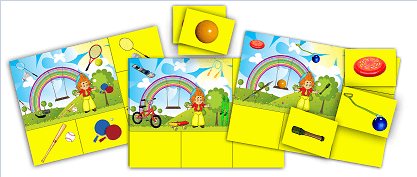
Didactic game on physical education for preschoolers
Card index of games on the topic “Health” for the preparatory group
Files of game cards on the topic: “Human health” I am a person
“I can, I can’t”
Objectives: to focus children's attention on their own capabilities and the physical capabilities of their own body; develop self-esteem.
The leader throws the ball and says “I can” or “I can’t.” The child, having taken the ball, continues the sentence, explaining why he cannot or cannot. For example: “I can run because I have legs. I can't fly because I don't have wings."
“Guess who called?”
Objectives: to train the hearing organs and activate the attention and auditory memory of children.
The presenter, standing with his back to the children, must verbally determine who called him. If the answer is correct, the child whose vote was determined takes the place of the leader.
“Find a match”
Goal: match a pair with an object by tactile sensation while blindfolded.
Equipment: buttons, cubes, apple, pencils, small objects.
Having chosen an object for himself, the child must, blindfolded, choose exactly the same one from the pile. At the end of the game, the facilitator asks to explain what helped the child correctly identify different materials by touch.
"Guess who"
Goal: to teach children the ability to mentally reproduce an image through their vision of a person.
The teacher chooses one of the children as the leader. The rest sit in a circle on chairs. The presenter must, without naming his name, tell the cook - one of the children: who he is, what he is capable of, what color his hair is, his eyes, what his face is like, what he wears, what his character is. After hearing the story, the children will guess who they are talking about. The one who guesses first comes to the place of the leader.
“What is a toy”
Goal: to teach the child self-determination, awareness of his body and its characteristics.
Equipment: toys of animals, birds, humans, pictures of different people.
The teacher invites the child to confront one or another toy: a duck, a bear, a clown, a soldier, a doll.
Sample answers from children: the duck has a beak, and I have a nose; the bear is shaggy and the skin is smooth; The dog has four legs, and I have two arms and two legs. The soldier and I are brave, I am alive, and although the doll is moving, it is not yet alive.
"My portrait"
Goal: to teach children to distinguish individual characteristics of their appearance: face, height, age.
Equipment: album sheets, colored pencils; exhibition stand; pictures of children (different in age, height, appearance). The teacher suggests looking at pictures of children of different ages in play situations. He asks how children see themselves: big, small or not so big. Children answer, show on their fingers how old they are, and say how they want to grow up. The teacher invites the children to draw themselves as they want to be.
Based on children's drawings on flannel, they try to guess who is depicted in them. The teacher asks whether height depends on whether a person is good or bad.
If you are small yourself
But with a high soul,
This signifies your true growth.
Above the most distant stars.
"Who am i?"
Goal: to expand the child’s knowledge about himself, his first name, last name, age.
Equipment: mirror; images of objects depicting animals, birds.
Tell us what you know about yourself (name, age, height, hair color and length, eye color, date of birth, girl or boy).
Tell us who you are like: mom or dad.
Do you have any signs that are present in any animal, bird?
"Gardener"
Objectives: deepen the child’s understanding of himself; They are taught to see the individual characteristics of other people.
Children stand in a circle. The presenter, the Gardener, throws the ball and says: “I was born a gardener, I was very angry, I was tired of all the flowers, except for Dasha.” Then the gardener draws a verbal portrait (name, age, eye color), and Dasha becomes the gardener.
What else to read: Zoo - lesson plan (senior group)
“Who was born as if”
Goal: to consolidate children’s understanding of how living beings are born.
Equipment: three large paintings depicting an egg, eggs, a bottle and a pacifier; pictures depicting people, animals, birds, amphibians, insects.
In front of the children are upside-down images of animals, insects, amphibians, and people. Children choose any image and tell how this creature was born. Then they combine a small image with a large one - with the image of an egg, an egg, a bottle with a nipple (for mammals).
Hygiene and ethics
"Hygiene rules"
Using the board, a driver is selected and leaves the group. The teacher and children agree on who and what they will portray. Then a driver is invited, the children take turns demonstrating hygiene skills using gestures and facial expressions. The presenter must guess what the children are being shown: brushing their teeth, brushing their teeth, combing their hair, bathing, washing.
"relay race"
Goal: to form an idea of personal hygiene items.
Equipment: various toys, musical instruments, clothing, hygiene items.
There are various objects on the tables. Children are divided into two teams. Each participant runs to the table, selects the required item for washing, places it on a tray, returns to his team and passes the baton to the next player.
"Smooth Circle"
Objectives: to explain children’s knowledge about personal hygiene items; develop creativity and imagination.
Equipment: hats - masks with soap, toothbrush, shampoo, washcloths, towels, mirrors, combs.
Children holding hands stand in a circle. In the center of the circle is a child playing the role of soap (he has a hat - a mask with a picture of soap), the children dance around him and sing.
In a single circle, one after another
We walk happily
What will soap show us here?
Then we will.
Soap shows how to wash your hands. Children repeat the movements. Then the corresponding movement is manifested by a towel, comb, washcloth, shampoo.
"Vacuum cleaner"
Goal: to develop dexterity, quick reaction, coordination of movements.
Equipment: 4 measuring spoons, 20 balls, 4 waste baskets.
The owner places the balls on the ground, and four children lift them with a shovel, without using their hands. Captured balls are placed in baskets.
"How to take care of yourself"
Goal: to develop skills in monitoring compliance with personal hygiene rules.
Equipment: top, chips, question cards.
The presenter turns over the top part, which identifies the question card. For the correct answer, the child receives a token. The one with the most chips wins.
- Name the things you need for washing (soap, towel).
- Name the items that need to be taken in the shower (shampoo, soap, shower gel).
- How often should you wash? (Every day).
- How often should you brush your teeth? (In the morning and in the evening).
- How often should you cut your nails? (At least once every 10 days).
- How often should you wash your ears? (Every day).
- How often should you change your underwear? (Every day).
"To keep your skin healthy"
Goal: to develop skills in monitoring compliance with personal hygiene rules.
"The fifth wheel"
Age 5-7 years The goal is to know and name sports equipment, to develop the ability to classify objects according to essential characteristics. Didactic material: a set of 10 cards, on each card there are 3 stripes depicting 5 items, 4 items are sports equipment, and 5 are extra. Each extra item in the strip belongs to a certain category (toys, fruits, vegetables, food, household appliances, furniture, kitchen utensils, interior items, hats) Progress of the game: Children name sports equipment, identify the extra picture, explaining their choice, name a generalization the concept of “extra” images. For example: 1 card: - basketball, volleyball, soccer ball, rubber ball - sports equipment, pyramid - toy, which means it is extra; - a puck, a baseball, a shuttlecock, a tennis ball - sports equipment, a drum - a toy, which means it is superfluous; - a baseball bat, a hockey stick, a tennis racket, a gymnastic stick - sports equipment, a truck - a toy, which means it is superfluous; Extra pictures are toys (general concept) It looks like this:
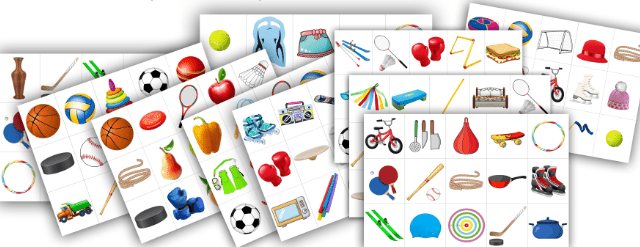
Didactic game cut pictures
"Fold the picture"
Age: 5 – 7 years. Pictures depicting sports are cut into various geometric shapes. The goal is to develop children’s interest in physical education and sports; introduce children to sports; teach children to recognize and name sports; develop imagination, thinking, logic. How to play: the player assembles a picture from parts. Having collected, the child tells what is shown in the picture. Looks like that:
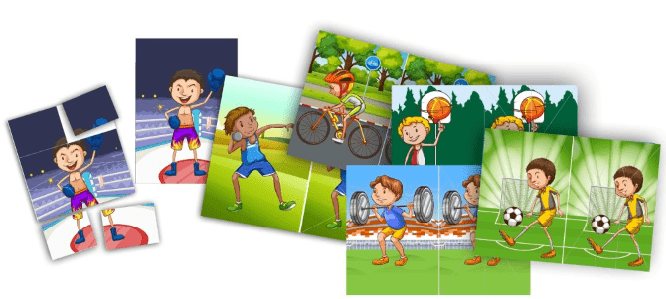
Didactic game
"Pictograms"
Age 5-7 years Set of 9 color cards depicting various sports and 9 pictogram cards of the presented sports. Goal: to develop children’s interest in physical education and sports; introduce children to various sports; teach children to recognize and name a sport by pictogram; develop thinking, attention, memory, logic. How to play. Before the game, a conversation is held with the children about sports, the children guess riddles (riddles are attached), and determine the characteristic features of the sports. Look at the color picture and match the pictogram to it. Looks like that:

The Pictograms game can be purchased in PDF format for color printing
Didactic games - sports and health.
Didactic game “Healthy and unhealthy food” .
Goal: to consolidate children’s understanding of which foods are healthy and which are harmful to the body.
Equipment: Green and red cards; subject pictures depicting food products (cake, lemonade, smoked sausage, cakes, candies, brown bread, porridge, milk, jam, juice, vegetables, fruits); incentive badges (apple, carrot, pear cut out of colored cardboard)
.
Children are given pictures depicting various foods. Place pictures of healthy food under the green picture, and pictures of unhealthy food under the red picture. Children must be careful; in case of an error, corrections are not allowed. The correct solution to a game problem is rewarded with a badge.
“Who needs what?” 6 - 7 years
Target:
to develop children’s interest in physical education and sports; introduce children to sports; teach children to recognize and name athletes and sports facilities, develop the ability to analyze and generalize; develop creative thinking and imagination.
Material:
cards with images of sports facilities (11 pcs.): hockey rink; tennis court; football field; basketball court; ice rink; jumping sector; Volleyball Court; gymnastic platform; treadmill; swimming pool; cycle track. Cards with images of athletes (11 pcs.)
Rules:
Option 1:
one player independently arranges the athletes to the appropriate sports facilities and names them correctly.
Complication:
you can do this for a while.
Option 2:
played by 2 or more players. The presenter sorts the cards into pairs and divides them equally between the players. On command, players must arrange the athletes to the appropriate sports facilities; the one who did it faster and named correctly wins.
"Sports Memorina" 5-7 years
Target:
continue to introduce children to various sports. Consolidate knowledge: winter, summer sports. Activate speech, attention, memory, reaction speed, logic.
Material:
paired cards depicting sports.
Rules:
2-5 people play. Cards are laid out on the table (face down) depicting sports. Children take turns turning over 2 cards and saying which sport is depicted. If the images of the cards match, then the child takes them for himself and makes another move. If the cards do not match, then the cards are turned face down and the turn passes to the next player. The one with the most pairs of cards wins. Complication: increase the number of cards, say the name of the athlete who practices this or that sport, name the necessary equipment.
Can be done on different topics: sports, equipment, sports facilities, physical exercise, healthy lifestyle and so on
Useful and harmful products
Target:
systematize children’s ideas about harmful and healthy products, exercise their ability to differentiate them, and develop the need to take care of their health
Material:
pictures depicting various products, two hoops
Progress of the game:
In order to be healthy, you need to eat right. Now we will find out if you know which foods are healthy.
The teacher offers the children pictures using two hoops. In one hoop, children select healthy foods and explain their choice, in the second – foods that are harmful to health.
.
Didactic game “Who owns this?”
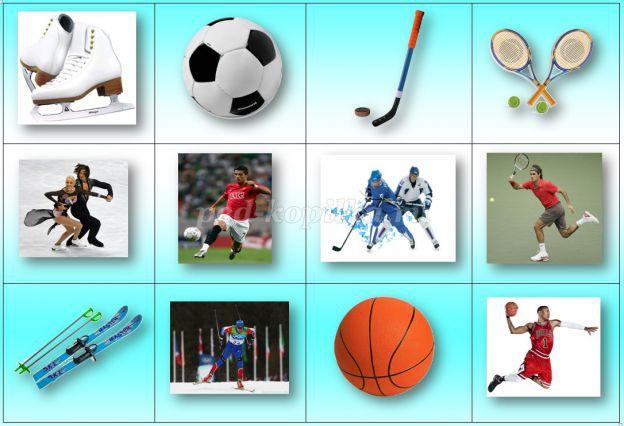
Before using, cut this sheet of pictures into cards. Game option: The child is asked to make pairs of pictures, find a suitable athlete for each piece of sports equipment and name the sports equipment and the athlete or sport.
Didactic game “Name a winter sport”
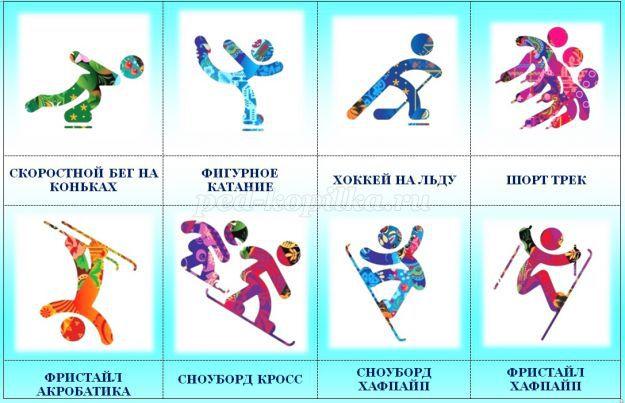
Methodology for working with the resource:
Option I: The child takes a card with the text, reads the name of the sport and selects the corresponding pictogram; if the child cannot read, then the name of the sport is read by an adult, and the child looks for the picture. Option II: Children are given cards with pictograms, the presenter (adult or child) reads the name of the sport, and the children look for the corresponding pictogram among their cards.
Didactic game "Couples"
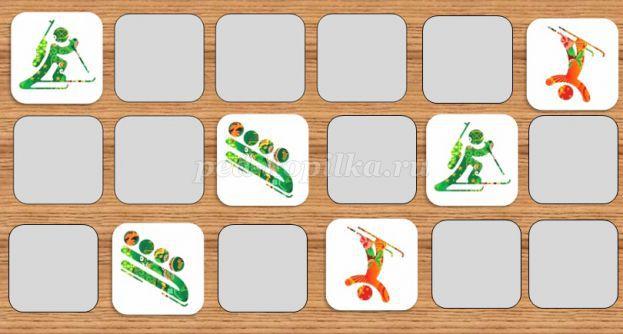
Option I: Cards are laid out face down in front of the child. Each card has a pair. The child turns over any two cards. If the images on the opened cards are identical, then the cards remain open; if not, then they are turned face down again and the child opens the next pair of cards. The game continues until all the cards are revealed. You can play alternately. The number of cards laid out is regulated by the adult depending on the level of development of the children.
